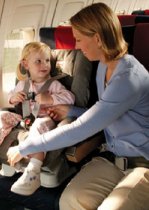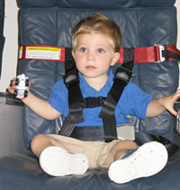
Child Safety

Did you know that the safest place for your child on an airplane is in a government-approved child safety restraint system (CRS) or device, not on your lap? Your arms aren't capable of holding your child securely, especially during unexpected turbulence.
The Federal Aviation Administration (FAA) strongly urges you to secure your child in a CRS or device for the duration of your flight. It's the smart and right thing to do so that everyone in your family arrives safely at your destination. The FAA is giving you the information you need to make informed decisions about your family's travel plans.
Media Kit
- Tips Sheet (PDF)
- E-News (PDF)
- Graphics
- About Child Restraint Systems (CRS)
- Installing a CRS on an Airplane
- Choosing a CRS Based on a Child's Weight
- FAA-Approved Child Harness Device (CARES)
- Tips for Parents
- Seat Fit
- Children with Special Needs
- Where Can I Find More Information?
About Child Restraint Systems (CRS)
 A CRS is a hard-backed child safety seat that is approved by the government for use in both motor vehicles and aircraft. FAA controls the approval of some but not all CRSs. Additional information is available on the National Highway Traffic Safety Administration website. Not all car seats are approved for use in airplanes.
A CRS is a hard-backed child safety seat that is approved by the government for use in both motor vehicles and aircraft. FAA controls the approval of some but not all CRSs. Additional information is available on the National Highway Traffic Safety Administration website. Not all car seats are approved for use in airplanes.
Make sure your CRS is government approved and has "This restraint is certified for use in motor vehicles and aircraft" printed on it. Otherwise, you may be asked to check the CRS as baggage.
Installing a CRS on an Airplane
Choosing a CRS Based on a Child's Weight
The FAA strongly urges you to secure your child in a CRS or device based on the child's weight. See the table below.
| If your child weighs… | Use a… |
|---|---|
| Less than 20 pounds | Rear-facing CRS |
| 20 to 40 pounds | Forward-facing CRS |
| 22 to 44 pounds | CARES child safety device |
| More than 40 pounds | Airplane seat belt |
Booster seats and harness vests enhance safety in vehicles. However, FAA prohibits passengers from using these types of restraints on airplanes during taxi, take-off and landing. These restraints should be checked as baggage. Also, supplemental lap restraints or "belly belts" are not approved for use in both airplanes and vehicles in the United States.
FAA-Approved Child Harness Device (CARES)
 The CARES Child Safety Device is the only FAA-approved harness-type restraint for children weighing between 22 and 44 pounds. This type of device provides an alternative to using a hard-backed seat and is approved only for use on aircraft. The CARES Child Safety Device is not approved for use in motor vehicles. Learn more about CARES.
The CARES Child Safety Device is the only FAA-approved harness-type restraint for children weighing between 22 and 44 pounds. This type of device provides an alternative to using a hard-backed seat and is approved only for use on aircraft. The CARES Child Safety Device is not approved for use in motor vehicles. Learn more about CARES.
If you're using a CARES child safety device, make sure it has "FAA Approved in Accordance with 14 CFR 21.8(d), Approved for Aircraft Use Only" or "FAA Approved in Accordance with 14 CFR 21.305(d), Amd 21.50 6-9-1980, Approved for Aircraft Use Only" on it.
Installing a CARES Child Safety Device on an Airplane
Tips for Parents
- Make sure your CRS or device is approved for use on airplanes.
- Measure the width of your CRS. It should fit in most airplane seats if it is no wider than 16 inches.
- Ask your airline for a discounted fare. Buying a ticket for your child is the only way to guarantee that you will be able to use a CRS.
- Reserve adjoining seats. A CRS should be placed in a window seat so it will not block the escape path in an emergency. Do not place a CRS in an exit row.
- If you do not buy a ticket for your child, ask if your airline will allow you to use an empty seat. If your airline's policy allows this, avoid the busiest days and times to increase the likelihood of finding an empty seat next to you.
- Arrange for your airline to help you if you need help making a connecting flight. Carrying a CRS, a child, and luggage through a busy airport can be challenging.
- Pack a bag of toys and snacks to keep your child occupied during the flight.
- Always use a CRS when driving to and from the airport.
- Wear your seat belt at all times.
Seat Fit
If an approved CRS, for which a ticket has been purchased, does not fit in a particular seat on the aircraft, the airline is responsible for accommodating the CRS in another seat in the same class of service. The airline may have polices that dictate the specific safe seat locations for specific aircraft. See Regulatory Requirements Regarding Accommodation of Child Restraint Systems (PDF) to learn more.
Children with Special Needs
Children Under 18 with Special Needs
Most young children who use a CRS weigh 40 lbs. or less. However, there are some children with physical challenges who weigh more than 40 lbs. and need the support and security of a CRS or device so they can travel safely on an airplane.
Airlines must allow a child who is under the age of 18 to use an approved CRS that is properly labeled, appropriate for the child's weight, and as long as the child is properly secured in the CRS. Many companies manufacture CRSs approved for use on aircraft that are specifically designed for larger children who are physically challenged. Additional information is available from the National Highway Traffic Safety Administration.
Adults with Special Needs
Adults (18 years or older) who have physical challenges that require the support and security of a CRS or device in order to travel safely on an airplane may request an exemption to the FAA's regulations that require each passenger to be properly secured by a safety belt. This request may also be made by an airline on the passenger's behalf. Several companies manufacture restraint systems for adults with physical challenges.
How to submit a petition for exemption
- Go to http://www.regulations.gov/#!documentDetail;D=FAA-2007-0001-0001
- Click the "Comment Now" button.
- Fill out the information in #1 on the left side of the page.
- Go to #3 "Upload File(s)".
- Click the "Browse" button and go to your computer and upload your petition.
- Click "Submit".
To review previously granted exemptions on special needs travel, go to the FAA Automated Exemption System and type "7831" or "8264" in the "Exemption Number" search field and hit "enter" or click on "Search" on the left side of the screen. Highlight the document you wish to view and click on "View Document" on the left side of the screen.
Where Can I Find More Information?
FAA News Releases
Other Sites and FAQs
Page Last Modified: 01/09/13 17:05 EST